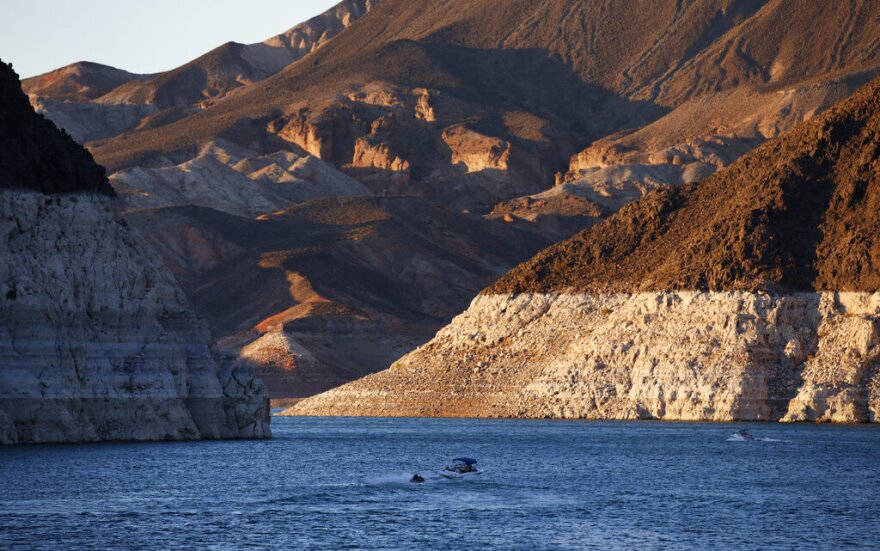ANDREW LIMBONG, HOST:
Today, the Biden administration unveiled its new proposal for managing the drought-stricken Colorado River. It has to act to prevent America's two biggest reservoirs from going so dry that they can no longer produce hydroelectric power. It's only a temporary plan, but it gives a window into how the Colorado River might be managed long term now that climate change has reduced the river's flow.
Here to explain is Michael Elizabeth Sakas with Colorado Public Radio. She's the host of their podcast on the river called "Parched." Hi, Michael.
MICHAEL ELIZABETH SAKAS, BYLINE: Hi, Andrew. Thanks for having me on.
LIMBONG: So it's been a crazy wet winter in the Western states. You know, there's still tons of snow in the mountains that feed the Colorado River. Do we really still need to worry about the reservoirs being so low?
SAKAS: Yeah. Unfortunately, one good winter or even a series of good winters won't be enough to get us out of this historic drought in the Southwest. Lake Mead and Lake Powell are the country's two largest reservoirs, and just last year, they both hit their lowest levels on record. More than 40 million people rely on the Colorado River. It produces hydropower, waters millions of acres of farmland and provides drinking water across the Southwest. And climate change means we have to start using this water differently. All this snow might have bought the states a little extra time to try and figure out how we're going to use less water, but the urgency is still there.
LIMBONG: Yeah. It sounds like the announcement today is really about who has to give up water, right?
SAKAS: Right. This emergency proposal from the feds essentially means the rules in place to keep enough water in Lake Powell and Lake Mead aren't cutting it, that something has to change. This draft plan essentially proposes bigger water cuts to the states that pull from these reservoirs. That's Nevada, Arizona and California. What needs to be ironed out is how those cuts would be shared. One option - California would mostly be spared from cuts because the state has the oldest legal rights to use the river. Or the three states could move away from the law and share these water cuts more evenly.
The feds didn't endorse any one single option, but they're using this emergency plan to spur the states and tribes to figure out what works best for them through working together. And today's proposed plan is a draft, and the public gets a chance to comment before any final decisions are made later this year. And any water cuts that would happen wouldn't be until the summer of 2024.
LIMBONG: But this plan is just temporary, right?
SAKAS: Yeah. The states and the feds have been working on this emergency short-term plan for months, but not everyone has been able to agree. This short-term fix is needed to keep the reservoirs from hitting dangerously low water levels, which would threaten hydropower production and the delivery of drinking water. So these draft rules from the feds, if adopted, could be in place for a year or two, and then after that, the states are expected to agree to a new set of longer-term rules on how to manage a drier Colorado River. Some of the Indigenous tribes in the Southwest are calling for more involvement in that process as well.
LIMBONG: All right. But what can this temporary plan tell us about how the Biden administration is just approaching this problem? Like, what kind of solutions are they working out long term?
SAKAS: Yeah. Last week, Biden's Interior Department released details on their big-picture plan for the Colorado River. That's part of a $15 billion package they call the largest investment in climate resilience in the nation's history. And that would include millions of dollars, potentially, to buy water from farmers in California and Arizona and the rivers upstream from these states. That plan would use Inflation Reduction Act and infrastructure law money to pay for the program for about three years. But people are waiting to see, anxiously, about what has to be done to keep more water in those reservoirs from going dry.
LIMBONG: That's Michael Elizabeth Sakas from Colorado Public Radio. She hosts the station's podcast about the Colorado River. It's called "Parched." Thanks, Michael.
SAKAS: Thank you, Andrew.
(SOUNDBITE OF BADBADNOTGOOD AND GHOSTFACE KILLAH'S "STREET KNOWLEDGE (FEAT. TREE)") Transcript provided by NPR, Copyright NPR.








